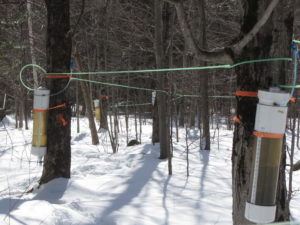
Tapped maple trees. Photo credit: https://botanistinthekitchen.wordpress.com
By Kirsti Blow, Center for Research on Vermont
The threat of climate change has proven to be one of the nation’s most momentous issues—just not in the concerns of the individual.
A majority of Americans believe in the existence of global warming, and as many as 69 percent of respondents across the country in a recent New York Times study expressed support for working toward imposing strict carbon dioxide emissions from existing coal-fueled power plants.
However, this figure shrinks dramatically when the question is reframed to ask if the respondents perceive that climate change will affect them individually. In Florida’s Miami-Dade County, which borders the ocean, between 60 and 70 percent of respondents expressed little concern for their own well-being.
In Vermont, between just 30 and 50 percent (depending on the county) of those surveyed believed that there would be an impact on their lives.
Though Vermont boasted one of the highest propensities for maintaining a dialogue about climate change and its effects, this threat-perception is dramatically lower than it should be when the state’s ski and sugaring industries are considered.
According to a 2014 report of projected climate change in the Lake Champlain Basin, daily temperatures are likely to increase by between 0.43 and 0.49 degrees Celsius (between 32.77 and 32.88 degrees Fahrenheit) per decade in the twenty-first century.
This spike in temperature poses significant consequences for a number of Vermont’s largest industries, including dairy farming, maple syrup production and ski resorts.
In fact, snowfall at six major ski resorts in the Lake Champlain Basin region is expected to decrease between 46.9 percent and 52.4 percent by the late twenty-first century. This will no doubt cause a reduction in recreational tourism, a valuable source of state income—and less snowy days for the state’s avid skiers and riders.
The maple syrup industry is no less of an economic driver, with a 131 percent growth in production between 1992 and 2014 in the U.S. In 2013, maple production yielded between $317 million and $330 million.
Sugar maples, however, require highly specific weather conditions in order to exude sap suitable for maple syrup production. With the rising temperatures and unpredictable weather events of a changing climate, the number of suitable days for production is projected to decrease.
Along with this time crunch, the annual peak production times in autumn and spring are likely to shift into midwinter. By mid- and late-century, the number of production days are projected to be reduced from 60.3 days in 2013 to 53 and 49, respectively.
As for dairy farms, rising temperatures and changing weather patterns are expected to affect agricultural productivity across the country, particularly in the Midwest. The corn, soybean and wheat supplies characteristic of that region are projected to decrease—likely hiking the cost and availability of animal feed in Vermont, and hindering dairy farms’ abilities to feed their livestock.
On paper, Vermont may seem to be a state with limited threats stemming from climate change—the northeast snow and land-locked mountains appear unlikely to be swept up by apocalyptic flooding. But the climbing temperatures and irregular weather patterns pose a real threat to the state’s most identifiable industries, and succeeding generations will undoubtedly feel the environmental constraints.
Kirsti Blow is a sophomore public communication major at University of Vermont. She writes the briefs for UVM’s Vermont research newsletter published by the Center for Research on Vermont. Learn more at http://www.uvm.edu/~crvt/. Kirsti is also a local musician in the Burlington area.








Leave a Reply